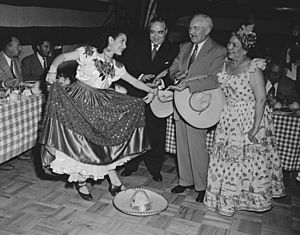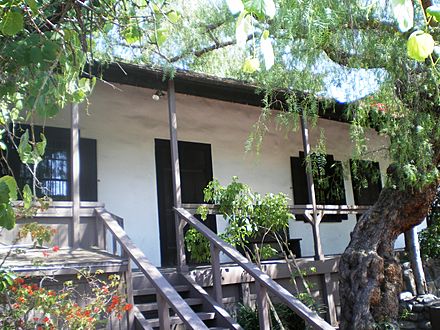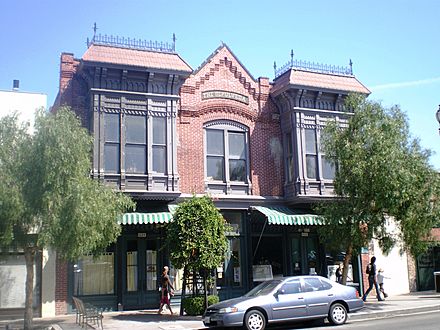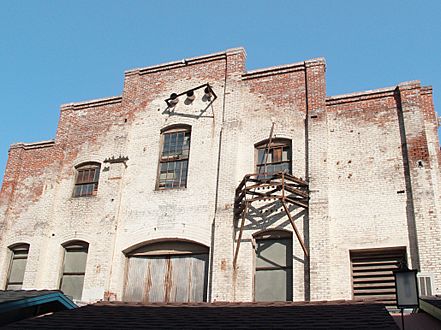Olvera Street facts for kids
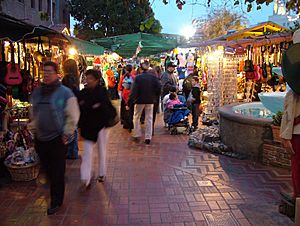
Olvera Street is a famous historic street in downtown Los Angeles. It is also known as Calle Olvera or Placita Olvera. This street is part of a special area called El Pueblo de Los Angeles Historic Monument. This area is around the old Los Angeles Plaza, which was the main town square in the 1820s when California was part of Mexico. Many old buildings are on Olvera Street, like the Avila Adobe from 1818, the Pelanconi House from 1857, and the Sepulveda House from 1887.
Today, Olvera Street is a lively marketplace. It has many restaurants and shops. It's a block-long, tree-shaded street with brick paths, perfect for walking. Many of the shop owners are related to the first people who opened businesses here in 1930. Back then, Olvera Street was old and run-down. It was rebuilt to look like a traditional Mexican market. The buildings and stalls are colorful, decorated with piñatas, Mexican pottery, and big sombreros. Almost two million people visit Olvera Street each year. It celebrates the history and traditions of Los Angeles's early Mexican settlers.
Where is Olvera Street?
Olvera Street is in the northeast part of Downtown Los Angeles. It is located between Main Street and Alameda Street. The street runs north from the Los Angeles Plaza to Cesar Chavez Avenue. It is part of the El Pueblo de Los Ángeles Historical Monument, which is the historic area around the Plaza. This spot is west of Union Station and southeast of Chinatown. Even though Los Angeles was founded in 1781, the current Plaza dates back to the 1820s. It is about one block east and south of the very first Plaza from the 1700s.
History of Olvera Street
Early Los Angeles
Los Angeles was started in 1781 by Spanish settlers called pobladores. They settled near the Los Angeles River, southeast of where Olvera Street is today. There were 11 families, making up 44 people, along with some Spanish soldiers. They came from Mission San Gabriel Arcángel to create a town called a pueblo. This new town was named El Pueblo de Nuestra Señora Reina de los Ángeles.
Priests from Mission San Gabriel built a small church, or asistencia, for the settlers. Later, the town built its own church, now known as the "Old Plaza Church". The first Plaza from the 1700s was a bit north and west of the current one. But floods made the settlers move to higher ground in the early 1800s. The current Plaza became the center of the new town.
Spanish rule ended when Mexico became independent in 1821. During this time, Los Angeles got its first streets and adobe buildings. Mexican rule lasted for 26 years. The Plaza was the heart of the community. People farmed in the old flood plain and raised cattle on ranches.
The Pelanconi House, a building on Olvera Street, was a winery in the late 1800s. It made wine from grapes that still grow there today. These grapes are the same type as those found at Mission San Gabriel Arcángel, which was built in 1771.
After the Mexican–American War, the Plaza stayed the center of town. A small street called Wine Street was renamed Olvera Street in 1877. It was named after Agustin Olvera, the first Superior Court Judge of Los Angeles County. He used to own an adobe house nearby. In the 1880s, Los Angeles grew very fast as many new settlers arrived.
As the city grew, the original settlement area became less important. It became a neighborhood for new immigrants, especially from Mexico and Sicily. There was also a Chinese community, which later moved to the nearby Chinatown to make space for Union Station. In the 1920s, many more Mexican immigrants came to California, with Los Angeles being a popular choice.
Saving and restoring Olvera Street
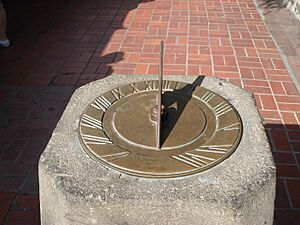
A woman named Christine Sterling started working to save the area in 1926. She heard that the Avila Adobe, the oldest house in the city, was going to be torn down. Sterling talked to the Los Angeles Chamber of Commerce and then to Harry Chandler, who owned the Los Angeles Times newspaper. She suggested creating a Mexican marketplace and cultural center in the Plaza area. Chandler liked the idea of celebrating the city's Mexican history in a fun, romantic way, like a theme park. He helped by giving the project a lot of attention in his newspaper.
By 1928, the project seemed to be failing because there wasn't enough money. Then, Sterling saw a notice that the Avila Adobe was going to be torn down. She put up her own sign, saying it was wrong to destroy such an important historic place. This helped get more public interest. The Los Angeles City Council changed its mind and decided to save the adobe. People from all over the city offered help. Building materials came from local companies. Even police Chief James Davis sent a crew of prison inmates to help with the hard work. Sterling managed the whole project herself.
Even with supplies and volunteers, the project still needed money. Harry Chandler stepped in and raised money by holding special luncheons. He started a company called the Plaza de Los Angeles Corporation to fund the restoration. In 1929, the street was closed to cars.
On Easter Sunday in 1930, Sterling's dream came true. The "Paseo de Los Angeles" opened, which became known as Olvera Street. It was called "A Mexican Street of Yesterday in a City of Today." Olvera Street quickly became a very popular place for tourists. A Spanish newspaper, La Opinión, praised it as "a street which recalls old Mexico."
Events
Blessing of the Animals
The Blessing of the Animals is a special event held on Olvera Street every year. It started in 1930 and takes place on Sábado de Gloria (Holy Saturday), the Saturday before Easter. This event used to be held on the Feast Day of Saint Anthony of the Desert, but it was moved for better weather.
What started as a small procession has grown into an all-day festival. There are vendors, performers, and a parade where people bring their pets and other animals. Religious leaders and others then give blessings to the animals. This event is shown in a mural on the Biscailuz Building called The Blessing of the Animals by Leo Politi. There is also a book with the same name about the event.
Landmarks
Gallery
Avila Adobe
The Avila Adobe at 10 Olvera Street was built in 1818 and is the oldest surviving residence in Los Angeles. It was built by Francisco Ávila, a wealthy cattle rancher. Its adobe walls are 2½ to 3 feet (0.91 m) thick. U. S. Navy Commodore Robert Stockton took it over as his temporary headquarters when the United States first occupied the city in 1846. Listed on the National Register of Historic Places, the adobe is also designated as California State Landmark No. 145. It was restored starting 1926 through efforts by Christine Sterling, and now stands as a museum.
Sepulveda House
The Sepulveda House at 12 Olvera Street is a historic residence built in 1887 by Señora Eloisa Martinez de Sepulveda in the East Lake architectural style. The original structure included two commercial businesses and three residences. It has since then become a preserved museum, and is cited by its website as a representation of the "blending of Mexican and Anglo culture".
Eloisa Martínez de Sepúlveda was born in the state of Sonora in Mexico. She lived there until 1844 when her parents, Francisca Gallardo and Estaquio Martinez, moved to Alta California at the urging of Francisca’s brother, bringing the 11-year-old Eloisa and her older brother Luis, with them to Los Angeles. In 1847, Señora Francisca Gallardo received from the ayuntamiento (Common Council) a plot of land between Bath and Wine street (renamed Olvera Street in 1877) on which she constructed an adobe residence. Señora Gallardo’s adobe home at number 12 Bath Street was later enlarged to include by 1870 a second story and hipped roof. When Eloisa married Joaquin Sepulveda at the age of 23, she brought with her a dowry of land and cattle. Joaquin was an undistinguished member of an illustrious Southern California family. Sadly, the marriage suffered from misfortune as the couple’s only child died in infancy and Joaquin himself died in 1880 leaving no property. Señora Gallardo gave her property to her widowed daughter, Eloisa Martinez de Sepulveda, in 1881. On lands owned by her mother, Eloisa was able to finance the construction of a commercial building which provided her with a steady income. This was the Sepulveda Block, built in 1887.
Señora Eloisa Martinez de Sepulveda built the two-story Sepulveda Block in 1887 in response to the city’s real estate and population boom of the 1800s. The twenty-two room building cost $8,000 to erect. As her husband, Joaquin Sepulveda, had died seven years earlier leaving no estate, Señora Sepulveda probably financed the construction of the building on her own. By 1888 Bath Street had been renamed Main Street and the city had realigned and widened it, cutting off 18 feet (5.5 m) from the front of the adobe. Señora Sepulveda received $1,190 in compensation.
When the Sepulveda Block was built in 1887 Señora Eloisa Sepulveda kept a suite of three rooms for her own use. Her bedroom reveals much about her Mexican heritage and the popular tastes and styles of the time. It would also reflect some of the places in Los Angeles in the decades following her arrival from Sonora in 1844. The décor of the room shows a practical acceptance of modern technology and contemporary fashion, with its mass-produced walnut furniture and gaslight chandelier. The bedroom has three different wallpapers and a typical flowered carpet. The somewhat cluttered appearance is characteristic of the period and a sign of modest prosperity. By contrast, the brass bed with its draperies and fancy spread, the Chinese shawl, and the well-tended shrine are representative of Señora Sepulveda’s Mexican upbringing and her strong religious beliefs. The large crucifix is on loan from Señora Sepulveda’s descendants while the bed belonged to the Avila family, who were related to her by marriage. The pastel portrait is of her favorite niece, Eloisa Martinez de Gibbs.
Señora Sepulveda chose American architects George F. Costerisan and William O. Merithew to design her two-story business block for residential and commercial rental in 1887. Although this particular type of building is probably unique in Los Angeles today, it was a “pattern book” building of a style that was common all over the country at the time. An exception in this building is the typically Mexican breezeway which separates the Main Street stores from the dwelling rooms in the rear. Thus, the Sepulveda Block represents the transition in Los Angeles from Mexican to a combination of Anglo and Mexican styles. The work “block” is the Victorian term for a large commercial building. By this time the city had changed from a Mexican pueblo with a cattle-based economy to an American town with an agricultural economy. The population had grown from less than 2000, most of whom were Mexican, to over 50,000, only 19% of whom were Mexican. When the building was constructed it appears that Señora Sepulveda herself occupied the three residential rooms located in the rear, facing Olvera Street, then an unpaved alley. Later, she may have occupied other quarters. Commercial tenants were located in the stores fronting on Main Street while the second floor was used as a boarding house.
Señora Sepulveda bequeathed the building on her death in 1903 to her favorite niece and goddaughter, Eloisa Martinez de Gibbs. Edward Gibbs, an engineer and lumber company owner, had been a tenant in the Sepulveda Block. In 1888, the same year that he and Eloisa were married, Edward was elected to the City Council. Four of their five children were born in the second floor facing Main Street on the south side. In 1905, along with many other residents of the area, the Gibbs moved to a more fashionable neighborhood in Los Angeles. Succeeding generations of the Gibbs family operated the Gibbs Electrical Company and retained ownership of the Sepulveda Block until it was acquired by the State of California for $135,000 in 1958 as part of the Pueblo de Los Angeles State Historic Monument.
Between 1982 and 1984 major restoration took place in the Sepulveda Block. The building was structurally stabilized and plumbing, heating, air conditioning and electrical systems were installed. A new roof replaced the old one and the front staircase, which had been removed in the 1930s, was put back. The iron cresting is restored as are the red tin tiles over the bay windows. The west façade is “penciled” in the style of the period, meaning that the bricks are painted and mortar lines are traced in white on top. The east façade on Olvera Street, although not originally painted, had previously been sandblasted, a process which destroys the outer surface of the brick, making it porous. As paint provides bricks with protective coating, they have been painted with the color which was first used in 1919. A 1983 archeological excavation beneath the wooden floor unearthed artifacts relating to the building’s history. Peter Snell, partner with Long Hoeft Architects and Gus Duffy Architect, were the firms responsible for the Sepulveda Block restoration plans and construction supervision.
During World War II the Sepulveda Block became a canteen for servicemen and three Olvera Street merchants were located in the building. The building continued to be used by Olvera Street merchants until 1881 when they were relocated for the building’s restoration. Today, El Pueblo Park’s Visitor’s Center is located in the south store on the ground floor. This room represents the Victorian Eastlake style of 1890. Restoration plans call for the creation of an 1890s grocery store on the north side of the first floor.
Mural América Tropical
The mural América Tropical (full name: América Tropical: Oprimida y Destrozada por los Imperialismos, or Tropical America: Oppressed and Destroyed by Imperialism, ) by David Siqueiros, was unveiled above the street in 1932. It was soon covered up to mask its political content. The Getty Conservation Institute has performed detailed conservation work on the mural to restore it and the America Tropical Interpretive Center opened to provide public access.
Plaza Substation
The Plaza Substation, also at 10 Olvera Street, was part of the electric streetcar system operated by the Los Angeles Railway. Completed in 1904, the substation provided electricity to power the yellow streetcars. When the streetcar system closed in the 1940s, the building was converted to other uses. The substation is one of the two buildings in the district that is separately listed in the National Register of Historic Places. (The Avila Adobe is the other.)
Pelanconi House
Pelanconi House at 17 Olvera Street, built in the 1850s, is the oldest surviving brick house in Los Angeles. In 1924, it was converted into a restaurant called La Golondrina, which is the oldest restaurant on Olvera Street. The Pelanconi House was a winery producing wine from the grapes that grew in the area, possibly even inside the Avila Adobe where they grow currently. The DNA matches that of grapes at Mission San Gabriel, established in 1771.
Plaza Methodist Church
Built in 1926, the Plaza Methodist Church was built in 1926 on the site of the adobe once owned by Agustín Olvera, the man for whom Olvera Street was named. It is at the southeast corner of Olvera Street and Paseo de la Plaza (i.e. the Plaza).
Eugene Biscailuz Building
The former United Methodist Church headquarters, also built in 1926, was renamed in 1965 for Sheriff Eugene W. Biscailuz, who had helped Christine Sterling to preserve and transform Olvera Street. It housed the Mexican Consulate until 1991 and then the Mexican Cultural Institute.
Images for kids
See also
 In Spanish: Placita Olvera para niños
In Spanish: Placita Olvera para niños


